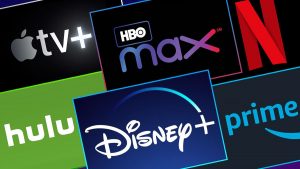For several years, we’ve heard about the trend of cord-cutting — TV consumers who are watching more content on streaming services, so they’ve abandoned the cable TV bundles they used to subscribe to. In response, the big networks have started their own streamers, like Peacock, Disney+, and Paramount+ (which was called CBS All Access until a couple of weeks ago). Those services coexist with Netflix, Amazon Prime Video, Hulu, Apple TV+, HBO Max, and the new Discovery+, to name just a few.
So, you cut the cord, got rid of that cable bundle, and now only have streaming subscriptions. How much does that cost?
Start with Netflix — the biggest must-have of them all for $9/month, or $16/month if you want several members of your family to be able to watch different streams simultaneously. Then add $7/month for Disney+, $5/month for Apple TV+, $5/month for ESPN+, and $15/month for HBO Max.
Still not enough content for you? You can get Showtime for $11/month, Starz for $9/month, PBS Passport for $6/month, and BET+ for $10/month.
Many of the services have different prices, depending on whether you’re willing to sit through commercials. For instance, Hulu is $6/month with ads, but $12/month without them. Paramount+ is $6/month with, $10/month without. Discovery+ is $5/month with, $7/month without.
Peacock has three tiers, one that’s free and ad-supported with limited content, another for $5/month with ads but more content, and a premium option for $10/month with almost no ads and even more content.
I’m not even including Amazon Prime Video, because most people get it as part of the overall Prime package, which includes lots of other non-TV perks.
If you merely signed up for the cheapest options for all of those services, you’d be laying out $115/month. Oh, and you still have to have either a (very) smart TV or some external device (Roku, Apple TV, Firestick) to access all of them.
At what point do you realize you’re paying more for TV with the cord cut than you were before all the streaming began? The problem is that, if you’re a big content consumer, you know that the vast majority of the good stuff now comes from those new services — and many of them offer libraries of movies and shows going back decades. On the other hand, none of this includes live TV and local channels, so there are no Sunday afternoon NFL games (unless you buy NFL Red Zone).
What I wonder is when some enterprising company will come along and disrupt the current system with something similar to what cable does — bundling access to multiple providers all in one service for one combined price. That’s gotta be the next disruption, right?
You know who’s likely to do that? Companies like Comcast, AT&T, Verizon, and Charter — the internet service providers who are the very same outlets that brought you all those cable TV bundles you no longer want.
Bottom line: you might think you’ve cut the cord and saved money, but you haven’t.

